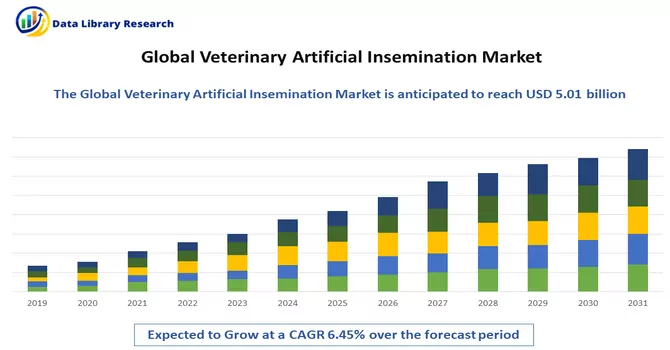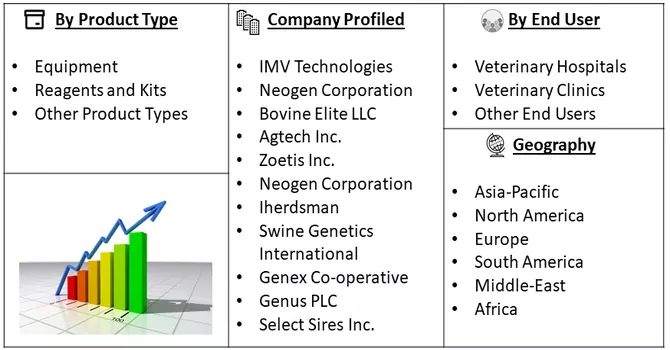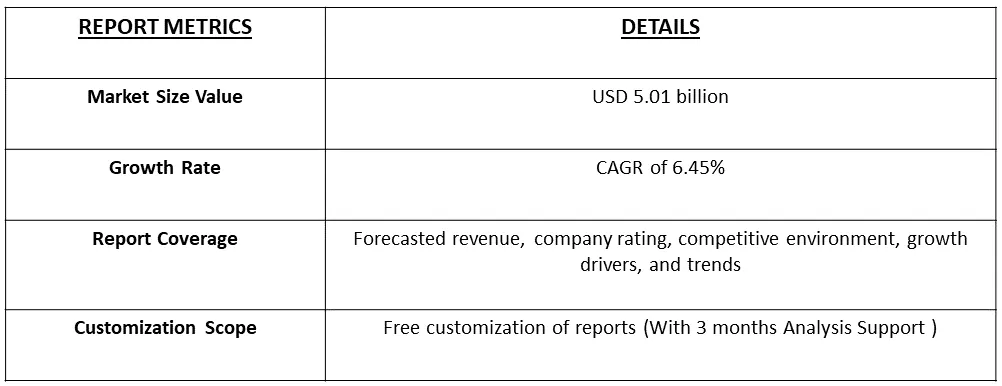The Veterinary Artificial Insemination Market is anticipated to witness substantial growth, projected to reach USD 5.01 billion by 2023 with an estimated Compound Annual Growth Rate (CAGR) of 6.45% during the forecast period from 2023 to 2030.

Get Complete Analysis Of The Report - Download Free Sample PDF
This market segment pertains to the application of artificial insemination techniques in animals for reproductive purposes. Predominantly employed in the livestock industry, encompassing cattle, pigs, sheep, and other animals, the aim is to enhance breeding efficiency, genetic selection, and overall reproductive performance.
The utilization of artificial insemination facilitates selective breeding, empowering farmers and breeders to elevate the genetic traits of animals. These traits encompass attributes like disease resistance, milk production, meat quality, and overall productivity. Artificial insemination offers a method for selective breeding, allowing breeders to utilize semen from high-quality males without the necessity for physical contact between the male and female. This streamlined approach results in a more expedited and controlled breeding process, ultimately boosting the reproductive efficiency of animals.
The ongoing progress in reproductive technologies, marked by enhancements in semen quality, preservation techniques, and artificial insemination (AI) procedures, is poised to elevate success rates and operational efficiency in artificial insemination practices. The burgeoning livestock industries in developing nations are anticipated to fuel a rising demand for sophisticated reproductive technologies, particularly artificial insemination, aimed at enhancing genetic traits and the overall productivity of livestock herds. As these advancements unfold, precision breeding is expected to integrate seamlessly with artificial insemination methodologies. This convergence involves leveraging technologies such as genomics and genetic markers, enabling a more meticulous selection of desirable traits in animals. The evolution of this trend holds the promise of further refining the precision and effectiveness of artificial insemination processes in the realm of animal breeding.
Market Segmentation: The Veterinary Artificial Insemination Market is Segmented by Product Type (Equipment, Reagents and Kits, and Other Product Types), End User (Veterinary Hospitals, Veterinary Clinics, and Other End Users), and Geography (North America, Europe, Asia Pacific, Middle East and Africa, and South America). The report offers the value (in USD million) for the above segments.

For Detailed Market Segmentation - Download Free Sample PDF
Market Drivers
Market Genetic Improvement In Livestock
Artificial insemination allows breeders to use semen from superior males, enhancing desirable traits such as disease resistance, milk production, and meat quality. Artificial insemination improves the overall reproductive efficiency of animals. It enables controlled breeding without the need for direct physical contact between males and females, resulting in a faster and more controlled reproduction process. AI helps control the spread of sexually transmitted diseases among animals since it eliminates the need for direct physical contact during mating. This is crucial for maintaining the health of livestock populations.
Reduction In The Transmission Of Diseases
The adoption of artificial insemination techniques in veterinary animals not only contributes to a reduction in the transmission of diseases but also enhances genetic efficiency and facilitates crossbreeding among animals. According to a study titled "Success rate of artificial insemination, reproductive performance and economic impact of the failure of first service insemination: a retrospective study," published in June 2022, artificial insemination (AI) stands out as the most effective method for augmenting reproductive capacity and has gained widespread application in farm animals in Ethiopia.
The success of AI is intricately linked to factors such as endometrial thickness, insemination timing, frequency of insemination, and ovarian stimulation protocols, as highlighted in the mentioned article. These factors are anticipated to play a pivotal role in driving the demand for artificial insemination (AI) and subsequently fuel market growth in the forecast period. Moreover, data from the Food and Agriculture Organization of the United Nations in October 2021 reveals that approximately 50% of the global population relies on fish consumption as a significant food source. This growing trend underscores the increasing need for larger animal production. Consequently, the demand for veterinary artificial insemination is expected to experience an upswing in response to the imperative of meeting elevated production requirements in the livestock and aquaculture sectors. Thus, due to the above-mentioned factors are expected to drive the growth of the studied market over the forecast period.
Market Restraints
High Initial Setup Costs and Shortage Of Skilled Professionals
The initiation of artificial insemination programs necessitates substantial investments in infrastructure, equipment, and training. The considerable upfront costs can pose a formidable barrier for smaller farms or enterprises with constrained financial resources. The efficacy of artificial insemination programs hinges on the expertise of trained professionals proficient in the proper techniques of semen collection, storage, and insemination. However, the demand for specialized training can present a limitation, particularly in regions where access to education and training resources is restricted. This underscores the challenge of ensuring a skilled workforce in areas where such expertise is crucial for the success of artificial insemination initiatives.
The veterinary sector in various countries has experienced substantial negative repercussions from the COVID-19 pandemic, significantly impacting multiple facets of the industry. The global supply chain disruptions triggered by the pandemic have reverberated into the veterinary domain, affecting the availability of essential supplies and equipment required for veterinary practices, including artificial insemination procedures. Furthermore, the lockdowns, travel restrictions, and adherence to social distancing protocols have compounded the challenges by potentially causing labor shortages in the agriculture and veterinary sectors. This scarcity of skilled personnel not only affects the execution of artificial insemination procedures but also poses obstacles in training new professionals. The disruptions in livestock and poultry value chains due to the pandemic have led to a decline in the procurement and sale of animal-sourced food. Animals, in turn, have suffered from inadequate feed and veterinary care, which includes the timely implementation of crucial procedures such as artificial insemination, pregnancy checks, and de-worming. To address these challenges and ensure the well-being of farmers and employees amidst the pandemic, the Animal Husbandry Department of India took proactive measures. In June 2020, a program was launched to provide telephonic assistance to poultry farmers and owners. Moreover, artificial insemination services were extended to farmers at their doorstep during the COVID-19 crisis. These initiatives not only aimed to mitigate the adverse effects of the pandemic on the veterinary sector but also contributed to sustaining market growth in challenging circumstances.
Segmental Analysis:
Equipment Segment is Expected to Witness Significant Growth Over the Forecast Period.
In the artificial insemination process, a device is employed for collecting semen. This apparatus is commonly crafted from a robust, temperature-sensitive material designed to replicate the conditions of the female reproductive tract. Its primary purpose is to elicit reproductive behavior in males, facilitating the collection of semen. The process typically involves utilizing females in estrus (heat) to stimulate males for semen collection. Additionally, this device serves as a medium for diluting and extending semen, a crucial step in the artificial insemination procedure. Buffered solutions, enriched with nutrients and antibiotics, are employed for this purpose. The inclusion of these elements ensures the proper preservation and viability of the collected semen. Moreover, maintaining cleanliness and hygiene during semen collection and handling is imperative. Antiseptic solutions are employed to clean equipment and surfaces, mitigating the risk of contamination. This stringent hygiene protocol is essential to uphold the integrity of the semen sample and the overall success of the artificial insemination process. Thus, due to the above-mentioned advatnges, the segment is expected to witness significant growth over the forecast period.
Veterinary Hospitals Segment is Expected to Witness Significant Growth Over the Forecast Period.
Numerous geographic areas boast veterinary clinics dedicated to reproductive services catering to both small and large animals. Within these clinics, artificial insemination is frequently provided as a component of their comprehensive reproductive management services. Veterinary hospitals affiliated with universities or veterinary colleges may feature specialized reproductive departments offering artificial insemination services. Beyond clinical services, these facilities often engage in research and educational initiatives centered around animal reproduction. Thus, owing to such advatnges offered by veterinary hospitals, the segment is expected to witness significant growth over the forecast period.
Asia-Pacific Region Segment is Expected to Witness Significant Growth Over the Forecast Period.
Asia-Pacific, region is expected to witness significant growth over the forecast period owing to the growing animal and fishery industry and the increasing burden of sexually transmitted diseases.
Avian influenza poses a significant threat to various species of food-producing birds, including chickens, quails, and pet birds, due to its highly contagious nature. According to data from the World Organisation for Animal Health, last updated in 2021, Asian countries continue to experience substantial poultry losses as a result of avian influenza outbreaks. Concurrently, there is a growing trend in the adoption of artificial insemination to mitigate the risk of infectious disease transmission among veterinary animals.
A research article by M A Hannan et al., published in the Journal of Veterinary Medical Science in February 2019, highlighted the efficacy of embryo transfer through artificial insemination using frozen semen in enhancing the productivity of Japanese domestic and special riding horses. In India, the Animal Husbandry, Dairying, and Fisheries Department's 2020-2021 report indicates the introduction of a new technology for sexing semen. This innovative method involves sorting and eliminating sperm responsible for male calf birth, resulting in the production of only female calves. The government has proposed the adoption of this technology by providing 2,000 doses of such semen for artificial insemination in farmers' animals on a pilot basis.
For example, in August 2019, the Obstetrics department of Madras Veterinary College and the Department of Veterinary Gynecology initiated artificial insemination in cattle using sexed semen. These developments are anticipated to be significant contributors to market growth in the region.

Get Complete Analysis Of The Report - Download Free Sample PDF
The veterinary artificial insemination market is moderately competitive, with the presence of both international and local companies. Some of the companies in the veterinary artificial insemination market are:
Recent Developments
1) In April 2022, Over 400 mobile veterinary units have been approved by the central government for the over 4.6 crore livestock of Madhya Pradesh, India. Each vehicle will have a veterinarian, a paravet, and a vehicle driver-cum-assistant. It will have equipment related to veterinary, minor surgery, and artificial insemination among other facilities.
2) In August 2020, Cogent collaborated with AB Europe, a sheep breeding company, to launch a novel sexed semen service for sheep producers in the United Kingdom.
Q1. What was the Veterinary Artificial Insemination Market size in 2023?
As per Data Library Research Veterinary Artificial Insemination Market projected to reach USD 5.01 billion by 2023.
Q2. What is the Growth Rate of the Veterinary Artificial Insemination Market?
Veterinary Artificial Insemination Market is estimated Compound Annual Growth Rate (CAGR) of 6.45% during the forecast period.
Q3. Which are the major companies in the Veterinary Artificial Insemination Market?
IMV Technologies, Neogen Corporation, Bovine Elite LLC and Agtech Inc. are some of the major companies in the Veterinary Artificial Insemination Market.
Q4. Which region has the largest share of the Veterinary Artificial Insemination Market? What are the largest region's market size and growth rate?
Asia-pacific has the largest share of the market. For detailed insights on the largest region's market size and growth rate request a sample here
Data Library Research are conducted by industry experts who offer insight on industry structure, market segmentations technology assessment and competitive landscape (CL), and penetration, as well as on emerging trends. Their analysis is based on primary interviews (~ 80%) and secondary research (~ 20%) as well as years of professional expertise in their respective industries. Adding to this, by analysing historical trends and current market positions, our analysts predict where the market will be headed for the next five years. Furthermore, the varying trends of segment & categories geographically presented are also studied and the estimated based on the primary & secondary research.
In this particular report from the supply side Data Library Research has conducted primary surveys (interviews) with the key level executives (VP, CEO’s, Marketing Director, Business Development Manager and SOFT) of the companies that active & prominent as well as the midsized organization
FIGURE 1: DLR RESEARH PROCESS

Extensive primary research was conducted to gain a deeper insight of the market and industry performance. The analysis is based on both primary and secondary research as well as years of professional expertise in the respective industries.
In addition to analysing current and historical trends, our analysts predict where the market is headed over the next five years.
It varies by segment for these categories geographically presented in the list of market tables. Speaking about this particular report we have conducted primary surveys (interviews) with the key level executives (VP, CEO’s, Marketing Director, Business Development Manager and many more) of the major players active in the market.
Secondary ResearchSecondary research was mainly used to collect and identify information useful for the extensive, technical, market-oriented, and Friend’s study of the Global Extra Neutral Alcohol. It was also used to obtain key information about major players, market classification and segmentation according to the industry trends, geographical markets, and developments related to the market and technology perspectives. For this study, analysts have gathered information from various credible sources, such as annual reports, sec filings, journals, white papers, SOFT presentations, and company web sites.
Market Size EstimationBoth, top-down and bottom-up approaches were used to estimate and validate the size of the Global market and to estimate the size of various other dependent submarkets in the overall Extra Neutral Alcohol. The key players in the market were identified through secondary research and their market contributions in the respective geographies were determined through primary and secondary research.
Forecast Model
